window Acura TL 2000 3.2 Owner's Manual
[x] Cancel search | Manufacturer: ACURA, Model Year: 2000, Model line: TL, Model: Acura TL 2000Pages: 311, PDF Size: 3.05 MB
Page 5 of 311
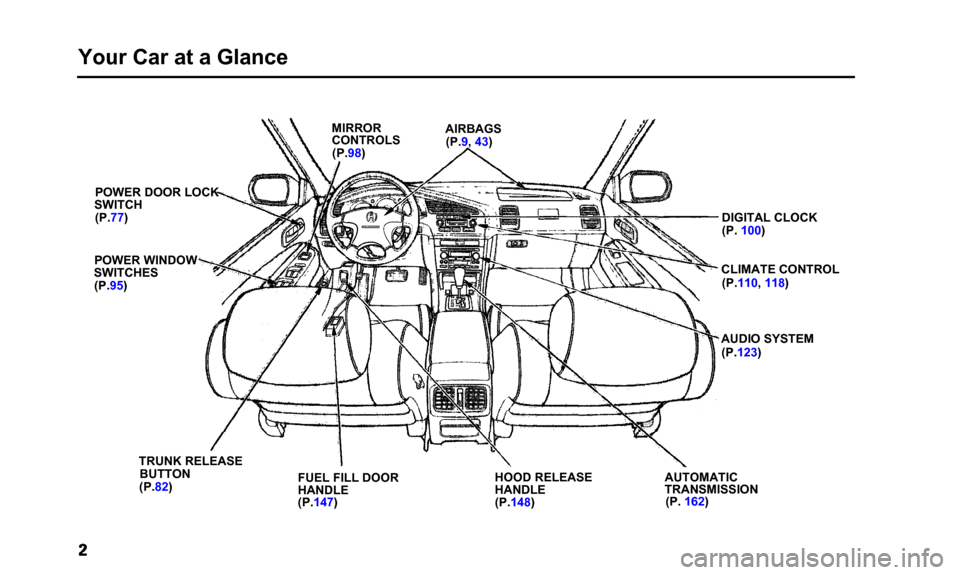
Your Car at a Glance
MIRROR
CONTROLS(P.98) AIRBAGS
(P.9, 43)
DIGITAL CLOCK
(P. 100)
CLIMATE CONTROL (P.110, 118)
AUDIO SYSTEM (P.123)
AUTOMATIC
TRANSMISSION (P. 162)
HOOD RELEASE
HANDLE
(P.148)
FUEL FILL DOOR
HANDLE
(P.147)
TRUNK RELEASE
BUTTON
(P.82)
POWER WINDOW
SWITCHES
(P.95) POWER DOOR LOCK
SWITCH
(P.77)
Page 6 of 311
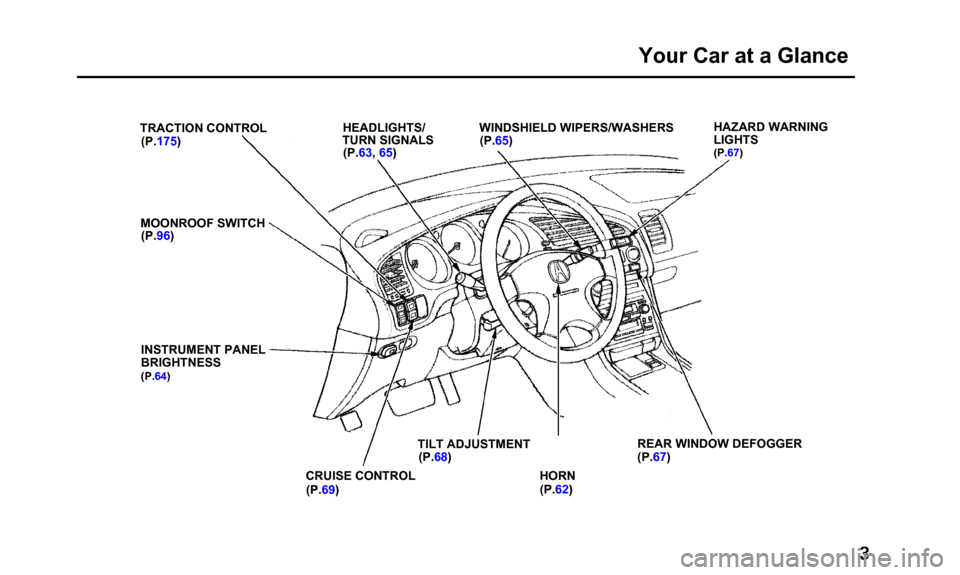
Your Car at a Glance
TRACTION CONTROL(P.175)
MOONROOF SWITCH (P.96)
INSTRUMENT PANEL
BRIGHTNESS
(P.64)
HEADLIGHTS/
TURN SIGNALS (P.63, 65) WINDSHIELD WIPERS/WASHERS
(P.65) HAZARD WARNING
LIGHTS
(P.67)
CRUISE CONTROL
(P.69) HORN
(P.62)
TILT ADJUSTMENT
(P.68) REAR WINDOW DEFOGGER
(P.67)
Page 26 of 311
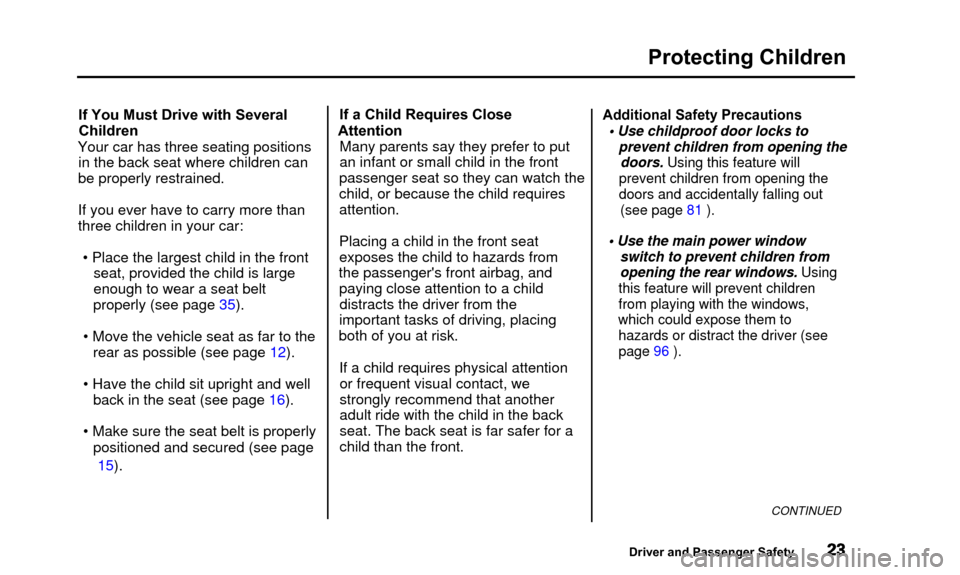
Protecting Children
If You Must Drive with SeveralChildren
Your car has three seating positions in the back seat where children can
be properly restrained.
If you ever have to carry more than
three children in your car:
• Place the largest child in the front seat, provided the child is large
enough to wear a seat belt
properly (see page 35).
• Move the vehicle seat as far to the rear as possible (see page 12).
• Have the child sit upright and well back in the seat (see page 16).
• Make sure the seat belt is properly positioned and secured (see page
15). If a Child Requires Close
Attention Many parents say they prefer to put
an infant or small child in the front
passenger seat so they can watch the
child, or because the child requires attention.
Placing a child in the front seat
exposes the child to hazards from
the passenger's front airbag, and paying close attention to a childdistracts the driver from the
important tasks of driving, placing
both of you at risk.
If a child requires physical attentionor frequent visual contact, we
strongly recommend that another
adult ride with the child in the backseat. The back seat is far safer for a
child than the front.Additional Safety Precautions
• Use childproof door locks to prevent children from opening thedoors. Using this feature will
prevent children from opening the
doors and accidentally falling out (see page 81 ).
• Use the main power window switch to prevent children from
opening the rear windows. Using
this feature will prevent children
from playing with the windows,
which could expose them to hazards or distract the driver (see
page 96 ).
CONTINUED
Driver and Passenger Safety
Page 52 of 311
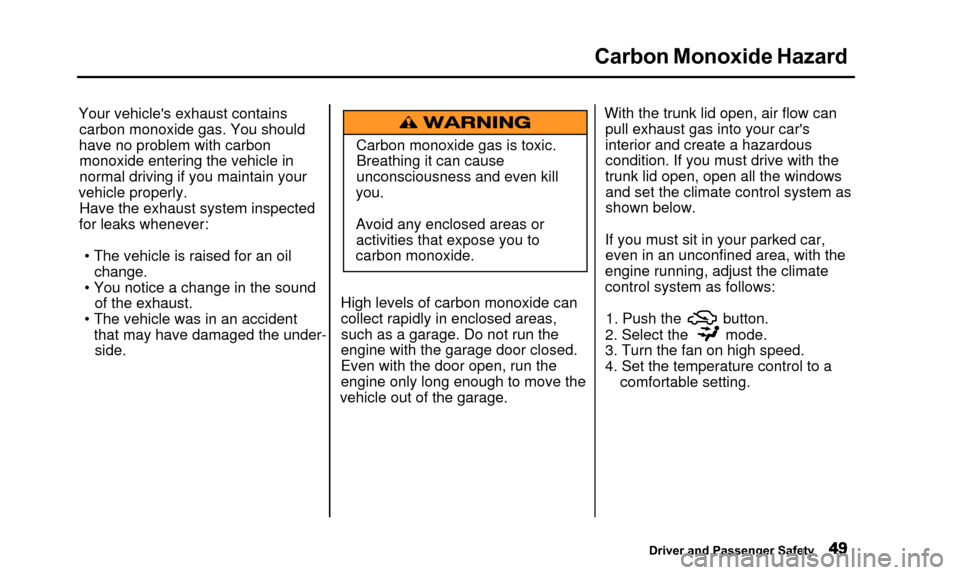
Carbon Monoxide Hazard
Your vehicle's exhaust containscarbon monoxide gas. You should
have no problem with carbon monoxide entering the vehicle in
normal driving if you maintain your
vehicle properly.
Have the exhaust system inspected
for leaks whenever:
• The vehicle is raised for an oil change.
• You notice a change in the sound of the exhaust.
• The vehicle was in an accident that may have damaged the under-side. Carbon monoxide gas is toxic.
Breathing it can cause
unconsciousness and even kill
you.
Avoid any enclosed areas or activities that expose you to
carbon monoxide.
High levels of carbon monoxide can
collect rapidly in enclosed areas, such as a garage. Do not run the
engine with the garage door closed.
Even with the door open, run the
engine only long enough to move the
vehicle out of the garage. With the trunk lid open, air flow can
pull exhaust gas into your car's
interior and create a hazardouscondition. If you must drive with the
trunk lid open, open all the windows and set the climate control system as
shown below.
If you must sit in your parked car, even in an unconfined area, with the
engine running, adjust the climate
control system as follows:
1. Push the button.
2. Select the mode.
3. Turn the fan on high speed.
4. Set the temperature control to a
comfortable setting.
Driver and Passenger Safety
Page 54 of 311
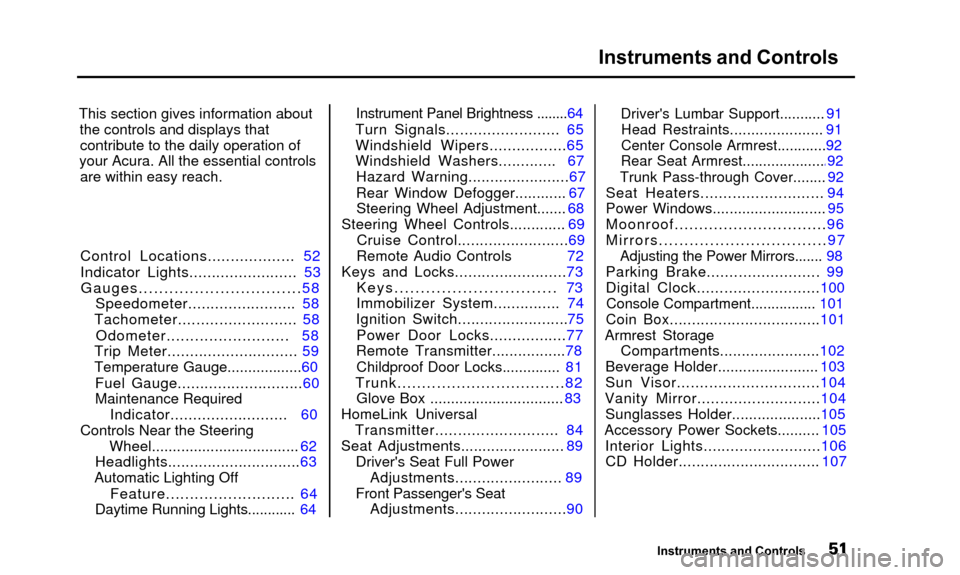
Instruments and Controls
This section gives information aboutthe controls and displays thatcontribute to the daily operation of
your Acura. All the essential controls are within easy reach.
Control Locations................... 52
Indicator Lights........................ 53
Gauges................................58
Speedometer........................ 58
Tachometer.......................... 58
Odometer.......................... 58
Trip Meter............................. 59
Temperature Gauge..................60
Fuel Gauge............................60
Maintenance Required Indicator.......................... 60
Controls Near the Steering
Wheel................................... 62
Headlights..............................63
Automatic Lighting Off
Feature........................... 64
Daytime Running Lights............ 64
Instrument Panel Brightness ........64
Turn Signals......................... 65
Windshield Wipers.................65
Windshield Washers............. 67 Hazard Warning....................... 67
Rear Window Defogger............ 67
Steering Wheel Adjustment....... 68
Steering Wheel Controls............. 69 Cruise Control.........................69
Remote Audio Controls 72
Keys and Locks.........................73
Keys............................... 73
Immobilizer System............... 74
Ignition Switch ......................... 75
Power Door Locks.................77
Remote Transmitter.................78
Childproof Door Locks.............. 81
Trunk.................................. 82
Glove Box ................................ 83
HomeLink Universal Transmitter........................... 84
Seat Adjustments........................ 89
Driver's Seat Full PowerAdjustments........................ 89
Front Passenger's Seat Adjustments.........................90
Driver's Lumbar Support........... 91Head Restraints...................... 91
Center Console Armrest............92
Rear Seat Armrest....................4 92
Trunk Pass-through Cover........ 92
Seat Heaters........................... 94
Power Windows........................... 95
Moonroof...............................96
Mirrors.................................97
Adjusting the Power Mirrors....... 98
Parking Brake......................... 99
Digital Clock...........................100
Console Compartment................ 101
Coin Box..................................101
Armrest Storage
Compartments.......................102
Beverage Holder........................ 103
Sun Visor...............................104
Vanity Mirror........................... 104
Sunglasses Holder.....................105
Accessory Power Sockets.......... 105
Interior Lights..........................106
CD Holder................................ 107
Instruments and Controls
Page 55 of 311
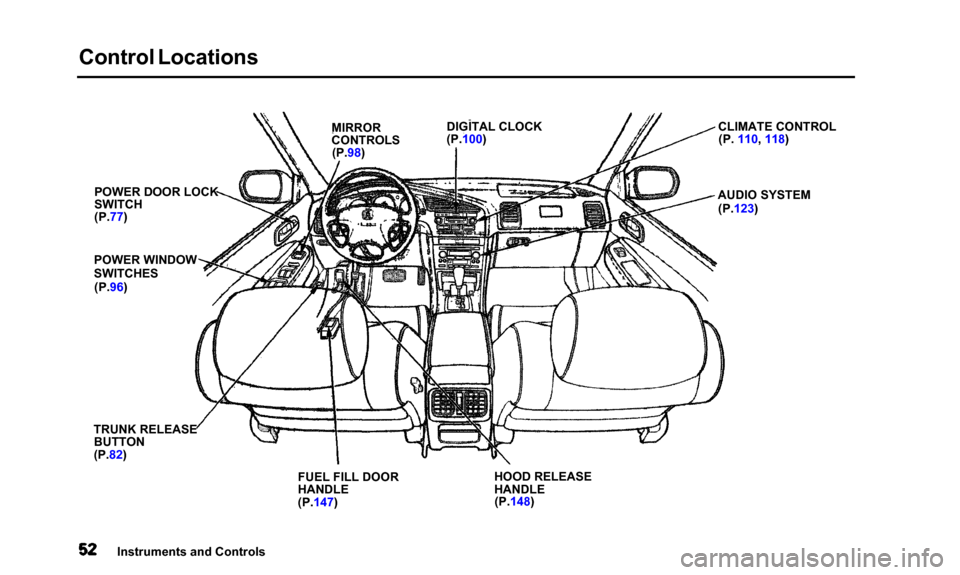
Control Locations
POWER DOOR LOCK
SWITCH
(P.77)
POWER WINDOW
SWITCHES (P.96)
TRUNK RELEASE BUTTON
(P.82)
FUEL FILL DOOR
HANDLE
(P.147)HOOD RELEASE
HANDLE
(P.148) CLIMATE CONTROL
(P. 110, 118)
AUDIO SYSTEM (P.123)
Instruments and Controls DIGITAL CLOCK
(P.100)
MIRROR
CONTROLS
(P.98)
Page 65 of 311
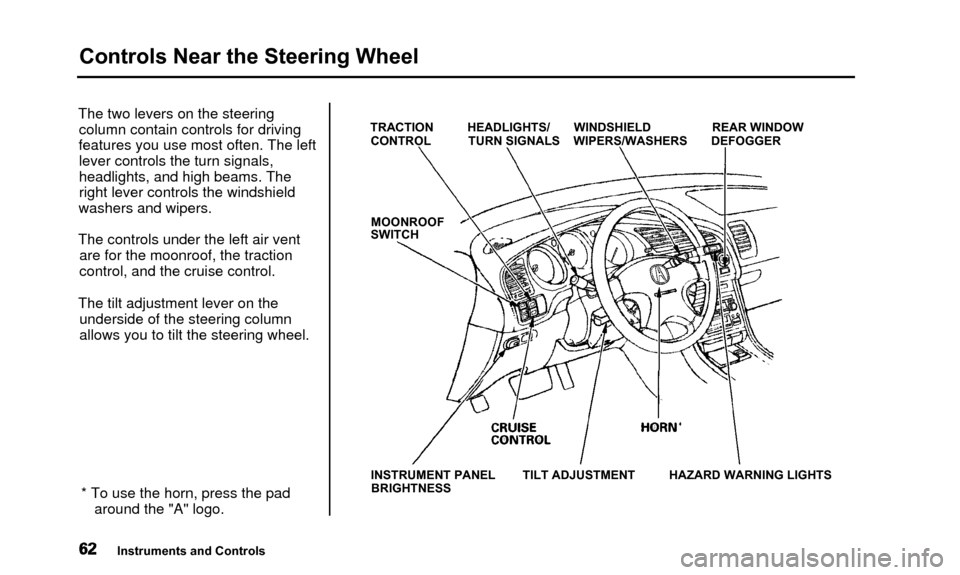
Controls Near the Steering Wheel
The two levers on the steeringcolumn contain controls for driving
features you use most often. The left lever controls the turn signals,
headlights, and high beams. The
right lever controls the windshield
washers and wipers.
The controls under the left air vent are for the moonroof, the traction
control, and the cruise control.
The tilt adjustment lever on the underside of the steering column
allows you to tilt the steering wheel.
* To use the horn, press the pad around the "A" logo.TRACTION HEADLIGHTS/ WINDSHIELD REAR WINDOW
CONTROL TURN SIGNALS WIPERS/WASHERS DEFOGGER
MOONROOF
SWITCH
INSTRUMENT PANEL TILT ADJUSTMENT HAZARD WARNING LIGHTS
BRIGHTNESS
Instruments and Controls
Page 70 of 311
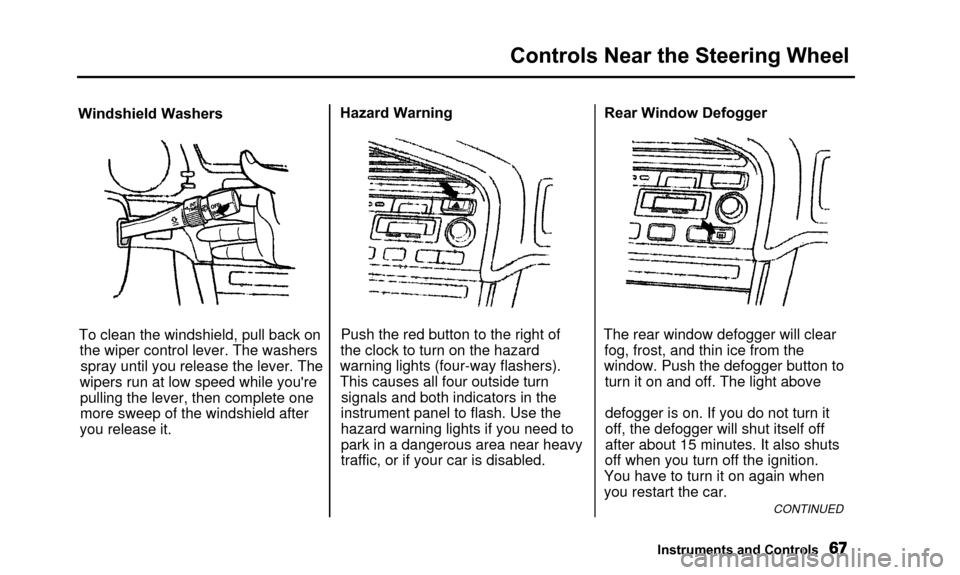
Controls Near the Steering Wheel
Windshield WashersTo clean the windshield, pull back onthe wiper control lever. The washersspray until you release the lever. The
wipers run at low speed while you're pulling the lever, then complete one
more sweep of the windshield after
you release it. Hazard Warning
Push the red button to the right of
the clock to turn on the hazard
warning lights (four-way flashers).
This causes all four outside turn signals and both indicators in the
instrument panel to flash. Use the
hazard warning lights if you need to
park in a dangerous area near heavy
traffic, or if your car is disabled. Rear Window Defogger
The rear window defogger will clear fog, frost, and thin ice from the
window. Push the defogger button to turn it on and off. The light above
defogger is on. If you do not turn it
off, the defogger will shut itself off
after about 15 minutes. It also shuts
off when you turn off the ignition.
You have to turn it on again when
you restart the car.
CONTINUED
Instruments and Controls
Page 71 of 311

Controls Near the Steering Wheel
Make sure the rear window is clear
and you have good visibility before
starting to drive.
The defogger and antenna wires on the inside of the rear window can beaccidentally damaged. When
cleaning the glass, always wipe side
to side. Steering Wheel Adjustment
See page 17 for important safety
information about how to properly
position the steering wheel.
Make any steering wheel adjustment
before you start driving.
Adjusting the steering wheelposition while driving may
cause you to lose control of the
car and be seriously injured in a
crash.
Adjust the steering wheel only
when the car is stopped.
To adjust the steering wheel upward or downward:
1. Push the lever under the steering column all the way down. 2. Move the steering wheel to the
desired position, making sure the
wheel points toward your chest, not toward your face. Make sure
you can see the instrument panel gauges and the indicator lights.
3. Push the lever up to lock the steering wheel in that position.
4. Make sure you have securely locked the steering wheel in place
by trying to move it up and down.
Instruments and Controls
Page 98 of 311

Power Windows
Your car's windows are electrically-powered. Turn the ignition switch to ON (II) to raise or lower any window.
Each door has a switch that controls
its window. To open the window,
push the switch down and hold it. Release the switch when you want
the window to stop. Close the
window by pushing the switch up and holding it.
DRIVER'S WINDOW
SWITCH MAIN
SWITCH
The driver's door armrest has a
master power window control panel.
To open any of the passengers' win- dows, push down on the appropriate
switch and hold it down until the
window reaches the desired position.
To close the window, pull back on the window switch. Release theswitch when the window gets to the
position you want.
CONTINUED
Instruments and Controls
Closing a power window on
someone's hands or fingers can
cause serious injury.
Make sure your passengers are
away from the windows before
closing them.